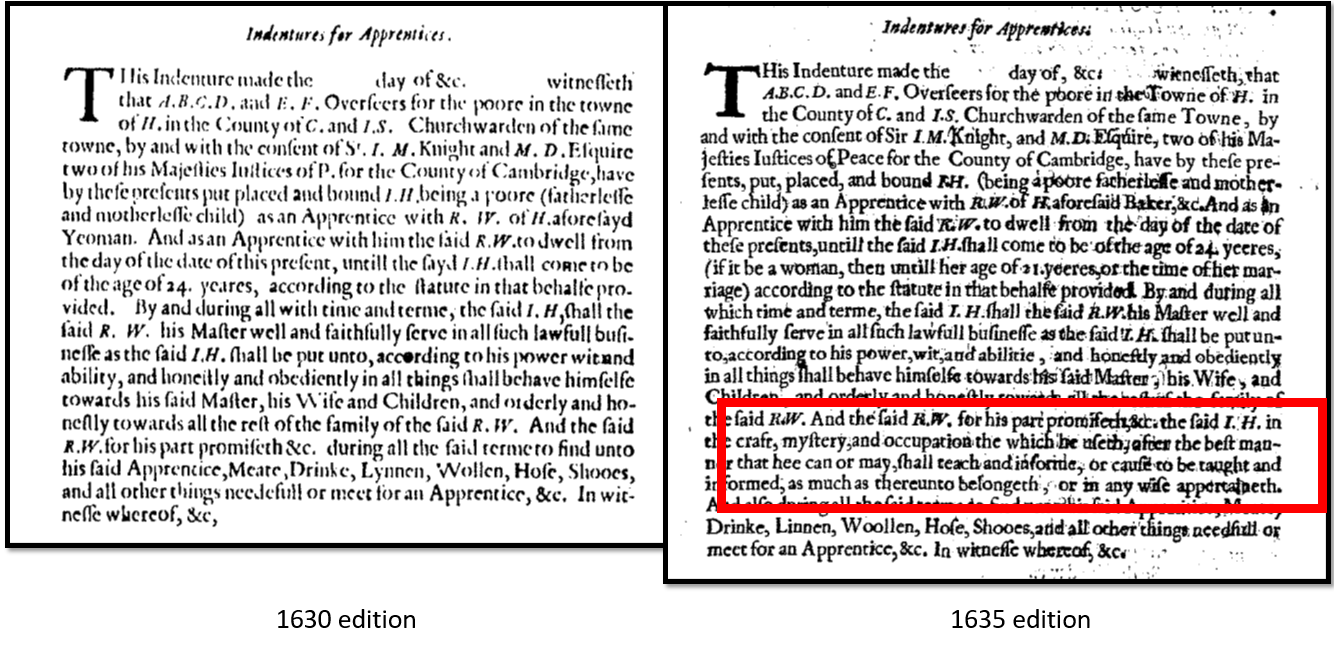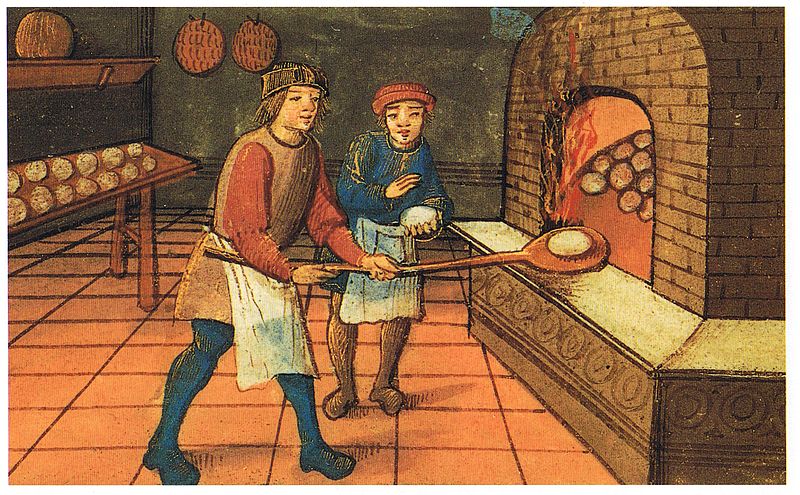James Fisher
This is the second post in a short series on different strands of research into pauper apprenticeships as a compulsory form of labour. Read Part I here.
The essence of an apprenticeship is the exchange of labour for training. Hence when examining pauper apprenticeships, we immediately have to confront the basic question: Were they seriously intended to provide training for poor children, and if so, to what extent was this achieved in practice?
After over a century of scholarship there is still no clear consensus. Broadly speaking, a negative view has prevailed that training was not the primary policy aim of pauper apprenticeships or a key contractual duty of the master. Instead, the aim was simply for the child to be maintained and to relieve the burden on their parents and the poor rate.[1] But this account has been repeatedly challenged by those who paint a more nuanced or even positive picture.[2] In particular, many have insisted that there was at least a minimal intention for children to learn something of practical use to enable them to support themselves in adulthood.[3]
One way we can examine the intentions of authorities is to focus on the apprenticeship contracts (indentures) that defined the legal arrangement and specified the duties of the master.
Indentures for regular apprenticeships had become standardised before 1600 and included a key training clause, which stated that the master ‘shall teach and inform, or cause to be taught and informed’ in their respective art, craft or trade. We can therefore ask: was this same clause also used for contracts for poor children? Let’s first look at models provided in printed guidebooks, before a sample of actual copies of surviving indentures.
Handbook Models
A survey of seventeenth-century handbooks for officials shows that no clear consensus emerged on the inclusion or phrasing of a training clause for pauper apprentices.
The first model indenture for a poor child apprentice appeared in a printed handbook for magistrates in 1630 – and notably this one did not include any training clause.[4] However, significantly, in the 1635 edition the standard training clause was (re)included, and then maintained in 1643, 1655 and 1666 (see image below). This apparent uncertainty was typical. Throughout the later seventeenth century some guides offered models with training clauses and some did not.

The model indentures for poor children printed in Michael Dalton’s The Country Justice in 1630 and 1635. The training clause is highlighted in red.
The lack of an agreed standard was exhibited most clearly in the editions of a guide by a Justice of the Peace in Kent.[5] The second edition (1682) presented an alternative to the standard training clause, obliging the master to ‘educate and bring up, or cause to be educated and brought up, in his Trade’, later copied by other guides. But the third edition (1685) provided another model alongside the first which contained the standard training clause. Notably both models of the indenture were kept in the next four editions up to 1703.
With a variety of model contracts available, what was written in actual contracts?
A sample from Devon gives a flavour of the variety and patterns. At present I have only analysed a relatively small sample of 366 indentures from between 1600 and 1699, but with reasonable representation from each decade and a range of 21 parishes (both rural and urban), and the expected gender ratio (38% girls, 62% boys). Some early patterns are suggestive, but this is not a fully representative sample so please don’t take the precise numbers too seriously.
Two initial broad patterns can be identified:
- Over half (61%) of these indentures contained a training clause, and the clause remained prevalent in every decade throughout the century, which is consistent with the uncertainty in handbooks
- A training clause was more likely to be included for children bound to trades rather than husbandry or housewifery, which aligns with our expectations
We can also categorise the type of training clause into three main types: (1) the standard clause for private indentures, with the key phrase ‘to teach and instruct’, which was most common (52% of clauses) and dominant up to 1660; (2) a much weaker alternative clause that the master must ‘bring up, or cause to be brought up in’ the relevant art or trade, which became dominant after 1660 (38%); (3) miscellaneous, a mix of the above phrases (9%).
If we breakdown these clause types by gender and trade, we find a clear pattern:
- A weaker training clause was more likely to be used for (a) girls and (b) husbandry/huswifery.
To summarise, children bound to farm work in rural areas were less likely to have a training clause in their indenture, and when they did, it was more likely to be a weaker obligation to be ‘brought up’ in the art of husbandry or huswifery, which was proportionally more common for girls than boys. The development of the Type 2 ‘bring up’ clause from the 1660s (linked to printed templates) neatly expresses the distinctive expectation for pauper apprentices, especially in farming communities.
Underlying these trends are differences between the distinctive local economies and administrative habits of different parishes. These geographical patterns will be a key focus of further analysis.
Variety & Uncertainty
The lack of a fixed standard and the varied patterns of use can largely be explained by understanding pauper apprenticeships as a social policy with social aims, which allowed a flexible approach to individual children. There is no single answer to the question ‘Were children intended to be trained through pauper apprenticeships?’. If the overriding aim was to preserve the social order by reproducing the labouring poor as a whole, then pauper apprenticeships were a key tool to ensure that, collectively, young people from poor families were channelled into subordinate working roles within their communities. That meant different outcomes in different places for different children. It meant some boys, and even some girls, were trained to fill low status trades, while most were prepared for a life time of service and wage labour in rural households.
However, while it is possible to find signs of conscious and deliberate inclusion or exclusion, there are many other signs that suggest its use was more arbitrary. For example, in the small rural community of Awliscombe, two different printed templates were used in the 1670s and 80s, one with a Type 2 clause and one without a clause. Four indentures all dated 4th October 1682, for three girls and one boy, are almost identical, except an indenture for one girl includes a weak training clause. The difference here would appear to be an arbitrary administrative quirk.
It could be suggested that the apparent arbitrariness was a consequence of its irrelevance – that it simply didn’t matter whether it was included or not. But this is not a satisfying explanation. If the training clause was meaningless, why was it not discarded completely? If it was merely nominal, with no practical effect, why not include it in all indentures? Why does it continually disappear then reappear?
I suggest that the irregular use of the training clause was a symptom of a genuine uncertainty and uneasiness. This perhaps arose from the fact that the apprenticeship model was originally a convenient way to regulate poor youth by binding them to long-term service, but whose coercive aspects were in principle supposed to be justified by the provision of training. As a consequence, the question of training haunted the policy throughout its first century.
[1] The tone was set by J. Dunlop and R.D. Denman, English apprenticeship and child labour: a history (1912), 251-252. More recently see Joan Lane, Apprenticeship in England, 1600-1914 (1996), 189; Steve Hindle, On the Parish?: The Micro-Politics of Poor Relief in Rural England c.1550-1750 (2004), 210; Patricia Crawford, Parents of Poor Children in England 1580-1800 (2010), 217.
[2] For positive reappraisal, see Ann Minister, ‘Pauper Apprenticeship in South Derbyshire: A Positive Experience?’ in Anne M. Scott (ed.), Experiences of poverty in late medieval and early modern England and France (2012).
[3] For example, Icy Pinchbeck and Margaret Hewitt, Children in English Society Volume I: From Tudor Times to the Eighteenth Century (1969), 235.
[4] Michael Dalton, The Country Justice (1630), 391.
[5] Richard Kilburne, Choice presidents upon all Acts of Parliament relating to the Office and Duty of a Justice of Peace (2nd ed., 1681), 23.

